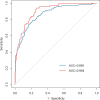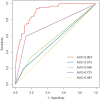Derivation, validation and assessment of a novel nomogram-based risk assessment model for venous thromboembolism in hospitalized patients with lung cancer: A retrospective case control study
- PMID: 36300098
- PMCID: PMC9589115
- DOI: 10.3389/fonc.2022.988287
Derivation, validation and assessment of a novel nomogram-based risk assessment model for venous thromboembolism in hospitalized patients with lung cancer: A retrospective case control study
Abstract
Purpose: This study aimed to develop and validate a specific risk-stratification nomogram model for the prediction of venous thromboembolism(VTE) in hospitalized patients with lung cancer using readily obtainable demographic, clinical and therapeutic characteristics, thus guiding the individualized decision-making on thromboprophylaxis on the basis of VTE risk levels.
Methods: We performed a retrospective case-control study among newly diagnosed lung cancer patients hospitalized between January 2016 and December 2021. Included in the cohort were 234 patients who developed PTE and 936 non-VTE patients. The patients were randomly divided into the derivation group (70%, 165 VTE patients and 654 non-VTE patients) and the validation group (30%, 69 VTE patients and 282 non-VTE patients). Cut off values were established using a Youden´s Index. Univariate and multivariate regression analyses were used to determine independent risk factors associated with VTE. Variance Inflation Factor(VIF) was used for collinearity diagnosis of the covariates in the model. The model was validated by the consistency index (C-index), receiver operating characteristic curves(ROC) and the calibration plot with the Hosmer-Lemeshow goodness-of-fit test. The clinical utility of the model was assessed through decision curve analysis(DCA). Further, the comparison of nomogram model with current models(Khorana, Caprini, Padua and COMPASS-CAT) was performed by comparing ROC curves using the DeLong's test.
Results: The predictive nomogram modle comprised eleven variables: overweight(24-28) defined by body mass index (BMI): [odds ratio (OR): 1.90, 95% confidence interval (CI): 1.19-3.07], adenocarcinoma(OR:3.00, 95% CI: 1.88-4.87), stageIII-IV(OR:2.75, 95%CI: 1.58-4.96), Central venous catheters(CVCs) (OR:4.64, 95%CI: 2.86-7.62), D-dimer levels≥2.06mg/L(OR:5.58, 95%CI:3.54-8.94), PT levels≥11.45sec(OR:2.15, 95% CI:1.32-3.54), Fbg levels≥3.33 g/L(OR:1.76, 95%CI:1.12-2.78), TG levels≥1.37mmol/L (OR:1.88, 95%CI:1.19-2.99), ROS1 rearrangement(OR:2.87, 95%CI:1.74-4.75), chemotherapy history(OR:1.66, 95%CI:1.01-2.70) and radiotherapy history(OR:1.96, 95%CI:1.17-3.29). Collinearity analysis with demonstrated no collinearity among the variables. The resulting model showed good predictive performance in the derivation group (AUC 0.865, 95% CI: 0.832-0.897) and in the validation group(AUC 0.904,95%CI:0.869-0.939). The calibration curve and DCA showed that the risk-stratification nomogram had good consistency and clinical utility. Futher, the area under the ROC curve for the specific VTE risk-stratification nomogram model (0.904; 95% CI:0.869-0.939) was significantly higher than those of the KRS, Caprini, Padua and COMPASS-CAT models(Z=12.087, 11.851, 9.442, 5.340, all P<0.001, respectively).
Conclusion: A high-performance nomogram model incorporated available clinical parameters, genetic and therapeutic factors was established, which can accurately predict the risk of VTE in hospitalized patients with lung cancer and to guide individualized decision-making on thromboprophylaxis. Notably, the novel nomogram model was significantly more effective than the existing well-accepted models in routine clinical practice in stratifying the risk of VTE in those patients. Future community-based prospective studies and studies from multiple clinical centers are required for external validation.
Keywords: lung cancer; nomogram model; risk assessment; thromboprophylaxis; venous thromboembolism.
Copyright © 2022 Li, Tian, Niu, He, Cao, Zhang, Kaiweisierkezi and Luo.
Conflict of interest statement
The authors declare that the research was conducted in the absence of any commercial or financial relationships that could be construed as a potential conflict of interest.
Figures






Similar articles
-
Derivation and validation of a nomogram model for pulmonary thromboembolism in patients undergoing lung cancer surgery.Transl Lung Cancer Res. 2021 Apr;10(4):1829-1840. doi: 10.21037/tlcr-21-109. Transl Lung Cancer Res. 2021. PMID: 34012796 Free PMC article.
-
Development and validation of a risk assessment nomogram for venous thromboembolism associated with hospitalized postoperative Chinese breast cancer patients.J Adv Nurs. 2021 Jan;77(1):473-483. doi: 10.1111/jan.14571. Epub 2020 Nov 6. J Adv Nurs. 2021. PMID: 33159325
-
Development and validation of a nomogram to assess postoperative venous thromboembolism risk in patients with stage IA non-small cell lung cancer.Cancer Med. 2023 Jan;12(2):1217-1227. doi: 10.1002/cam4.4982. Epub 2022 Jun 27. Cancer Med. 2023. PMID: 35758614 Free PMC article. Clinical Trial.
-
Derivation and External Validation of a Risk Assessment Model of Venous Thromboembolism in Hospitalized Chinese Patients.Clin Appl Thromb Hemost. 2023 Jan-Dec;29:10760296221151164. doi: 10.1177/10760296221151164. Clin Appl Thromb Hemost. 2023. PMID: 36650933 Free PMC article. Review.
-
Venous thromboembolism risk assessment scale for prediction of venous thromboembolism in inpatients with cancer: A meta-analysis.Thromb Res. 2024 Aug;240:109058. doi: 10.1016/j.thromres.2024.109058. Epub 2024 Jun 2. Thromb Res. 2024. PMID: 38875848 Review.
Cited by
-
Development, validation, and clinical utility of risk prediction models for cancer-associated venous thromboembolism: A retrospective and prospective cohort study.Asia Pac J Oncol Nurs. 2025 Mar 22;12:100691. doi: 10.1016/j.apjon.2025.100691. eCollection 2025 Dec. Asia Pac J Oncol Nurs. 2025. PMID: 40291141 Free PMC article.
-
Dynamic nomogram for predicting the overall survival and cancer-specific survival of patients with gastrointestinal neuroendocrine tumor: a SEER-based retrospective cohort study and external validation.Front Oncol. 2025 Jun 4;15:1594591. doi: 10.3389/fonc.2025.1594591. eCollection 2025. Front Oncol. 2025. PMID: 40535122 Free PMC article.
-
Profile of Solid Tumor Patients Complicated With Venous Thromboembolism: A 10-Year Retrospective Cross-Sectional Study Based on 1482 Cases.Clin Appl Thromb Hemost. 2023 Jan-Dec;29:10760296231169514. doi: 10.1177/10760296231169514. Clin Appl Thromb Hemost. 2023. PMID: 37062945 Free PMC article.
-
Development and Validation of a Predictive Nomogram for Venous Thromboembolism Risk in Multiple Myeloma Patients: A Single-Center Cohort Study in China.Biomedicines. 2025 Mar 21;13(4):770. doi: 10.3390/biomedicines13040770. Biomedicines. 2025. PMID: 40299376 Free PMC article.
-
The impact of COVID-19 on the prognosis of deep vein thrombosis following anticoagulation treatment: a two-year single-center retrospective cohort study.BMC Pulm Med. 2024 Apr 26;24(1):208. doi: 10.1186/s12890-024-03036-3. BMC Pulm Med. 2024. PMID: 38671424 Free PMC article.
References
LinkOut - more resources
Full Text Sources
Miscellaneous

